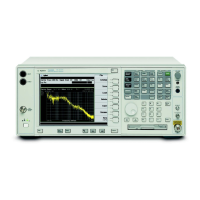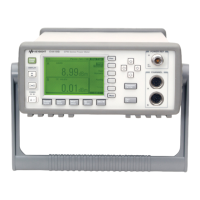Chapter 2 59
Overall Troubleshooting
Troubleshooting Using Front Panel Keys
50 MHz Oscillator
The
50 MHz Oscillator key performs the internal alignment routine using
a signal from the RF input (rather than the internal 50 MHz reference
signal) when Ext is selected. Ext mode disables the internal 50 MHz
reference oscillator and selects the RF input (when the
Align All Now
function is enabled.)
LO Null
The LO Null circuit on the A20 Lowband assembly reduces the
amplitude of the LO feedthrough that allows measurement of low level
signals near the LO feedthrough signal (O Hz).
LO Null On is the default
state.
LO Null can be used to help troubleshoot a low gain problem. Turning
off the nulling so the LO feedthrough amplitude increases gives you a
quick way to check that the first mixer is working. When
LO Null is set
to Off, the amplitude of the LO feedthrough should increase
approximately 40-50 dB. If it doesn’t, the first mixer or LO Null circuit
might be defective.
Noise Source
This key appears only if the Front End Driver assembly contains the
28V switch. Instruments with a serial prefix US4251 or MY4251 and
above all contain the 28V switch. Earlier instruments may have
received a Front End Driver replacement and also have the 28V switch.
Allows the 28V Noise Source Drive output on the rear panel to be
turned on and off. The 28V switch is located on the A13 Front End
Driver assembly.
Diagnostics
When
HW Diag is On, the following keys are active:
IF Ctrl
Main Gain DAC - Changing the DAC value from 0 to 4095 causes
about 20 dB change in displayed signal gain.
Pre-ADC BPF - Allows changing the bandwidth of the prefilter on the
analog IF assembly. The prefilter bandwidth range is 2.5 kHz to
2.83 MHz, although the instrument display shows the upper range
as 10 MHz. Above 2.83 MHz prefilter BW, the prefilter circuit
switches to bypass mode and the 10 MHz wide anti-alias filter
effectively sets the filtering through the analog IF assembly.

